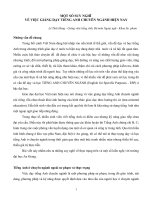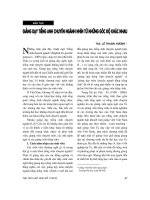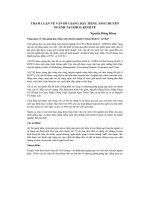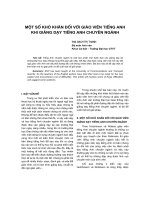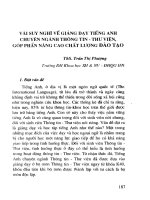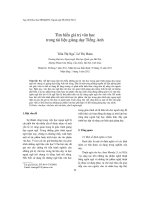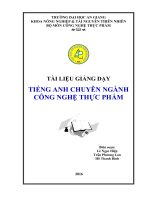Tài liệu giảng dạy tiếng Anh chuyên ngành Công nghệ thông tin (Ngành/nghề: Công nghệ thông tin - Trình độ: Cao đẳng/Trung cấp) - Trường CĐ Kinh tế - Kỹ thuật Vinatex TP HCM (2019)
Bạn đang xem bản rút gọn của tài liệu. Xem và tải ngay bản đầy đủ của tài liệu tại đây (1.37 MB, 53 trang )
TẬP ĐỒN DỆT MAY VIỆT NAM
TRƢỜNG CAO ĐẲNG CƠNG NGHỆ TP. HCM
TÀI LIỆU GIẢNG DẠY
MÔN HỌC/MÔ ĐUN: TACN CÔNG NGHỆ THƠNG TIN
NGÀNH/NGHỀ: CƠNG NGHỆ THƠNG TIN
TRÌNH ĐỘ: CAO ĐẲNG/ TRUNG CẤP
…………, năm 2019
English for information technology
TUYÊN BỐ BẢN QUYỀN
Tài liệu này thuộc loại tài liệu giảng dạy nội bộ sử dụng trong nhà trường với mục
đích làm tài liệu giảng dạy cho giảng viên và sinh viên nên các nguồn thông tin có
thể tham khảo.
Mọi mục đích khác mang tính lệch lạc hoặc sử dụng với mục đích kinh doanh thiếu
lành mạnh sẽ bị nghiêm cấm.
LỜI GIỚI THIỆU
Tài liệu được biên soạn theo chương trình đào tạo nghề môn tiếng Anh chuyên
ngành Công nghệ thông tin của Trường cao đẳng công nghệ thành phố Hồ Chí
Minh. Tài liệu được viết theo các chủ đề liên quan đến ngành công nghệ thông tin .
Cấu trúc tài liệu gồm 7 bài. Mỗi bài có 3 phần: Tasks, language work, reading
comprehension.
Trong quá trình biên soạn, mặc dù đã có nhiều cố gắng nhưng khơng tránh khỏi
những hạn chế và thiếu sót nhất định, Tổ bộ mơn Ngoại ngữ rất mong nhận được
những ý kiến đóng góp của quý đọc giả để giáo trình này ngày càng hồn thiện
hơn.
Xin chân thành cảm ơn!
TP. HCM, ngày……tháng
năm 2019
Tham gia biên soạn
Võ Thị Diễm Hà
English for information technology
CHƢƠNG TRÌNH MƠN HỌC
Tên mơn học: TIẾNG ANH CHUYÊN NGÀNH
Mã môn học:
Thời gian thực hiện môn học: 45 giờ; (Lý thuyết: 42 giờ; Thực hành, thí nghiệm,
thảo luận, bài tập: 0 giờ; Kiểm tra: 3 giờ)
I. Vị trí, tính chất của mơn học:
- Vị trí: Mơn học đư c ph n b vào học k 4, sau mơn học Tiếng nh 1 và Tiếng
Anh 2.
- Tính chất: Là môn học chuyên môn ngành, nghề.
II. Mục tiêu môn học: Sau khi học xong môn học này, sinh viên đạt đư c:
- Về kiến thức:
+ Hiểu và sử dụng đư c từ vựng và thuật ngữ chuyên ngành tin học;
+ Vận dụng đư c kiến thức văn phạm về mạo từ bất định và mạo từ xác định; các
hình thức so sánh; liên từ; các thì của động từ (hiện tại đơn; tương lai đơn; hiện tại hoàn
thành); mệnh đề quan hệ; câu bị động; các cấu trúc câu về cách mô tả chức năng; cách
cho lời khuyên; cách diễn đạt về nguyên nhân, kết quả, c u điều kiện.
- Về kỹ năng:
+ Phát triển kỹ năng giao tiếp và dịch thuật các tài liệu chuyên ngành tin học;
+ Phát huy kỹ năng tự học và nghiên cứu tài liệu.
- Về năng lực tự chủ và trách nhiệm:
+ Nhận thức đư c ý nghĩa và tầm quan trọng của mơn học;
+ Rèn luyện kĩ năng nghe, nói, đọc, viết và làm việc nhóm;
+ Rèn đư c tính tự tin, phương pháp học tư duy, phát huy tính tích cực, chủ động
và sáng tạo trong học tập.
III. Nội dung môn học:
1. Nội dung tổng quát và ph n bổ thời gian:
Thời gian
STT
Tên chƣơng, mục
Tổng
Lý
Thực hành, thí
Kiểm
số
thuyết
nghiệm, thảo
tra
luận, bài tập
1
Unit 1: Computer uses
6
6
2
Unit 2: Types of computer
7
6
Achievement test 1
1
3
Unit 3: Keyboard and mouse
6
6
4
Unit 4: Input devices
7
6
Achievement test 2
1
5
6
7
Unit 5: Output devices
Unit 6: Storage Devices
Unit 7: Networks
Achievement test 3
Cộng
6
6
7
45
6
6
6
42
1
3
2. Nội dung chi tiết:
Unit 1: Computer uses
Thời gian: 6 giờ
1. Mục tiêu: Sau khi học xong bài này, sinh viên đạt đư c:
- Hiểu và trình bày đư c một s điểm văn phạm về: “ rticle”, “Pronouns”,
“Relative pronouns”, một s từ vựng và thuật ngữ về công nghệ thơng tin có trong bài;
- Phát triển kỹ năng ứng dụng những điều đã học vào các bài tập thực hành và
giao tiếp;
- Phát huy ý thức làm việc theo cặp/nhóm, trao đổi kinh nghiệm trong học tập và
tìm ra cách học phù h p cho bản th n, rèn luyện tính tự giác, hăng hái tham gia phát biểu
x y dựng bài.
2. Nội dung bài:
2.1. Vocabulary: Words about computer uses
Thời gian: 2 giờ
2.2. Grammar
2.2.1. Language work: Articles (with countable and uncountable nouns)
2.2.2. Pronouns
2.2.3. Relative pronouns
2.3. Reading & speaking
Thời gian: 2 giờ
2.3.1. Computers in everyday life
2.3.2. Uses of computer technology
2.3.3. Computer application
2.3.4. The computer
2.4. Practice: Do exercises
Thời gian: 2 giờ
2.4.1. Task 1
2.4.2. Task 2
2.4.3. Task 3
2.4.4. Task 4
2.4.5. Task 5
2.4.6. Task 6
2.4.7. Task 7
Unit 2: Types of computer
Thời gian: 7 giờ
1. Mục tiêu: Sau khi học xong bài này, sinh viên đạt đư c:
- Hiểu và trình bày đư c một s điểm văn phạm về: “Comparisons, Conjunctions”,
một s từ vựng và thuật ngữ về công nghệ thông tin ứng dụng của máy tính và các loại
máy tính có trong bài;
- Phát triển kỹ năng ứng dụng phần kiến thức vừa học vào các bài tập thực hành và
giao tiếp;
English for information technology
- Phát huy ý thức làm việc theo cặp/nhóm, trao đổi kinh nghiệm trong học tập và
tìm ra cách học phù h p cho bản th n, rèn luyện tính tự giác, hăng hái tham gia phát biểu
x y dựng bài.
2. Nội dung bài:
2.1. Vocabulary: words about types of computer
Thời gian: 2 giờ
2.2. Grammar
2.2.1. Comparisons of adjectives
2.2.2. Conjunctions
2.3. Reading & speaking
Thời gian: 2 giờ
2.3.1. The computer industry
2.3.2. Mainframe
2.4. Practice: Do exercises
Thời gian: 2 giờ
2.4.1. Task 1
2.4.2. Task 2
2.4.3. Task 3
2.4.4. Task 4
Achievement test 1
Thời gian: 1 giờ
Unit 3: Keyboard and mouse
Thời gian: 6 giờ
1. Mục tiêu: Sau khi học xong bài này, sinh viên đạt đư c:
- Hiểu và trình bày đư c một s điểm văn phạm về: “The simple present tense”,
“Relative clauses”, một s từ vựng và thuật ngữ về cơng nghệ thơng tin có trong bài về
các thiết bị bàn phím, chuột máy tính;
- Phát triển kỹ năng ứng dụng phần kiến thức vừa học vào các bài tập thực hành
và giao tiếp;
- Phát huy ý thức làm việc theo cặp/nhóm, trao đổi kinh nghiệm trong học tập và
tìm ra cách học phù h p cho bản th n, rèn luyện tính tự giác, hăng hái tham gia phát biểu
x y dựng bài.
2. Nội dung bài:
2.1. Vocabulary: words about computer devices
Thời gian: 2 giờ
2.2. Grammar
2.2.1. The simple present tense
2.2.2. Relative clauses
2.3. Reading & Speaking
Thời gian: 2 giờ
2.3.1. Informatics in engineering tasks
2.3.2. History of computer
2.4. Practice: Do exercises
Thời gian: 2 giờ
2.4.1. Task 1
2.4.2. Task 2
2.4.3. Task 3
2.4.4. Task 4
Unit 4: Input devices
Thời gian: 7 giờ
1. Mục tiêu: Sau khi học xong bài này, sinh viên đạt đư c:
- Hiểu và trình bày đư c một s điểm văn phạm về: “Word formation: suffix”,
“language work, function”, một s từ vựng và thuật ngữ về các thiết bị nhập;
- Phát triển kỹ năng ứng dụng phần kiến thức vừa học vào các bài tập thực hành
và giao tiếp;
- Phát huy ý thức làm việc theo cặp/nhóm, trao đổi kinh nghiệm trong học tập và
tìm ra cách học phù h p cho bản th n, rèn luyện tính tự giác, hăng hái tham gia phát biểu
x y dựng bài.
2. Nội dung bài:
2.1. Vocabulary: Words about input devices
Thời gian: 2 giờ
2.2. Grammar
2.2.1. The simple future tense
2.2.2. Passive voice
2.3. Reading & speaking
Thời gian: 2 giờ
2.3.1. Types of error
2.3.2. Hardware & software
2.4. Practice: Do exercises
Thời gian: 2 giờ
2.4.1. Task 1
2.4.2. Task 2
2.4.3. Task 3
2.4.4. Task 4
2.4.5. Task 5
Achievement test 2
Thời gian: 1 giờ
Unit 5: Output devices
Thời gian: 6 giờ
1. Mục tiêu: Sau khi học xong bài này, sinh viên đạt đư c:
- Hiểu và trình bày đư c một s điểm văn phạm về: “How to give advice, present
perfect tense”, một s từ vựng và thuật ngữ về thiết bị xuất khác như: màn hình và máy
in;
- Phát triển kỹ năng ứng dụng phần đã học vào các bài tập thực hành và giao tiếp;
- Phát huy ý thức làm việc theo cặp/nhóm, trao đổi kinh nghiệm trong học tập và
tìm ra cách học phù h p cho bản th n.
2. Nội dung bài:
2.1. Vocabulary: Words about output devices
Thời gian: 2 giờ
2.2. Grammar
2.2.1. Giving advice
2.2.2. The present perfect tense
2.3. Reading & speaking
Thời gian: 2 giờ
2.3.1. How to read monitor ad
2.3.2. Informatics in secretarial tasks
2.3.3. Printers
2.4. Practice: Do exercises
Thời gian: 2 giờ
2.4.1. Task 1
2.4.2. Task 2
Unit 6: Storage devices
Thời gian: 6 giờ
1. Mục tiêu: Sau khi học xong bài này, sinh viên đạt đư c:
English for information technology
- Hiểu và trình bày đư c một s điểm văn phạm về: “Linking words and
conjunctions”, một s từ vựng và thuật ngữ về công nghệ máy tính, thiết bị lưu trữ thơng
tin, cơng nghệ máy tính, xử lý dữ liệu, cơ sở dữ liệu;
- Phát triển kỹ năng ứng dụng phần đã học vào các bài tập thực hành và giao tiếp;
- Phát huy ý thức làm việc theo cặp/nhóm, trao đổi kinh nghiệm trong học tập và
tìm ra cách học phù h p cho bản th n.
2. Nội dung bài:
2.1. Vocabulary: Words about storage devices
Thời gian: 2 giờ
2.2. Grammar
2.2.1. Linking words
2.2.2. Conjunctions
2.3. Reading & speaking
Thời gian: 2 giờ
2.3.1. Data processing and database
2.3.2. Types of memory
2.4. Practice: Do exercises
Thời gian: 2 giờ
2.4.1. Task 1
2.4.2. Task 2
2.4.3. Task 3
2.4.4. Task 4
Unit 7: Networks
Thời gian: 7 giờ
1. Mục tiêu: Sau khi học xong bài này, sinh viên đạt đư c:
- Hiểu và trình bày đư c một s điểm văn phạm về: “Predicting consequences; if
clauses”, một s từ vựng và thuật ngữ về mạng máy tính;
- Phát triển kỹ năng ứng dụng phần đã học vào các bài tập thực hành và giao tiếp;
- Phát huy ý thức làm việc theo cặp/nhóm, trao đổi kinh nghiệm trong học tập và
tìm ra cách học phù h p cho bản th n.
2. Nội dung bài:
2.1. Vocabulary: Words about networks
Thời gian: 2 giờ
2.2. Grammar
2.2.1. Predicting consequences
2.2.2. If clauses
2.3. Reading & speaking
Thời gian: 2 giờ
2.3.1. Computer networks
2.3.2. Terminals
2.4. Practice: Do exercises
Thời gian: 2 giờ
2.4.1. Task 1
2.4.2. Task 2
2.4.3. Task 3
2.4.4. Task 4
2.4.5. Task 5
Achievement test 3
Thời gian: 1 giờ
IV. Điều kiện thực hiện mơn học:
1. Phịng học chun mơn hóa/nhà xưởng: phịng học lý thuyết
2. Trang thiết bị máy móc: máy tính, máy chiếu /LCD, phấn, bảng.
3. Học liệu, dụng cụ, nguyên vật liệu: tranh ảnh minh họa, tài liệu phát tay cho người học,
tài liệu tham khảo.
4. Các điều kiện khác: Không
V. Nội dung và phƣơng pháp đánh giá:
1. Nội dung:
- Kiến thức: Đánh giá thông qua bài kiểm tra thường xuyên; định k ; thi kết thúc môn
học, sinh viên cần đạt các yêu cầu sau:
+ Từ vựng chuyên ngành tin học theo các chủ điểm về máy tính, các loại máy tính,
các loại thiết bị xuất, nhập, lưu trữ, các thuật ngữ về mạng máy tính, các ứng dụng của
máy tính trong đời s ng, ... ;
+ Văn phạm về mạo từ bất định và mạo từ xác định; các hình thức so sánh tính từ,
trạng từ ; liên từ; các thì của động từ (hiện tại đơn; tương lai đơn; hiện tại hoàn thành);
câu phức có mệnh đề quan hệ; cấu trúc câu bị động qua các thì; các cấu trúc câu về cách
mơ tả chức năng; cách cho lời khuyên; cách diễn đạt về nguyên nhân, kết quả, c u điều
kiện.
- Kỹ năng:
+ Dịch thuật các tài liệu chuyên ngành tin học thể hiện qua các bài đọc hiểu;
+ Khả năng tự học và nghiên cứu tài liệu.
- Năng lực tự chủ và trách nhiệm: Đánh giá trong quá trình học tập cần đạt những yêu cầu
sau:
+ Chấp hành nội qui, qui chế của nhà trường;
+ Chuẩn bị đầy đủ tài liệu hoc tập;
+ Chuẩn bị đầy đủ nội dung tự học, tự nghiên cứu;
+ Tham gia đầy đủ thời lư ng môn học, tích cực trong giờ học.
2. Phương pháp: Các kiến thức và kỹ năng trên sẽ đư c đánh giá qua các nội dung tự
nghiên cứu, ý thức thực hiện môn học, kiểm tra thường xuyên, kiểm tra định k và bài
kiểm tra kết thúc môn học:
- Điểm môn học bao gồm điểm trung bình các điểm kiểm tra: tự nghiên cứu, điểm
kiểm tra thường xuyên, kiểm tra định k có trọng s 0,4 và điểm thi kết thúc mơn học có
trọng s 0,6;
- Điểm trung bình các điểm kiểm tra là trung bình cộng của các điểm kiểm tra
thường xuyên, kiểm tra định k và tự nghiên cứu theo hệ s của từng loại điểm. Trong đó,
điểm kiểm tra thường xuyên và điểm tự nghiên cứu đư c tính hệ s 1, điểm kiểm tra định
k tính hệ s 2;
- Hình thức thi: trắc nghiệm online 45 phút (đư c thông báo vào đầu mỗi học k ).
VI. Hƣớng dẫn thực hiện môn học:
1. Phạm vi áp dụng môn học: Chương trình mơn học Tiếng nh chun ngành sử dụng
để giảng dạy cho sinh viên trình độ cao đẳng.
2. Hướng dẫn về phương pháp giảng dạy, học tập môn học:
- Đ i với giảng viên:
English for information technology
+ Đ y là môn học gắn liền với thực tế nghề cơng nghệ thơng tin, vì vậy giảng viên
nên kết h p nhiều phương pháp như thuyết trình, đàm thoại, giảng giải, nêu vấn đề, vấn
đáp, thảo luận và đóng vai hội thoại;
+ Trước khi giảng dạy, giảng viên cần căn cứ vào nội dung của từng bài học để
chuẩn bị đầy đủ các điều kiện cần thiết nhằm đảm bảo chất lư ng giảng dạy;
+ Nên hướng dẫn bài tập tự nghiên cứu mang tính minh họa để sinh viên hiểu và
hoàn thành t t bài tập đư c giao.
- Đ i với người học:
+ Chuẩn bị nội dung thảo luận nhóm, nội dung tự học tự nghiên cứu khi đến lớp;
+ X y dựng kế hoạch tự học, tự nghiên cứu cho từng cá nh n;
+ Nghiên cứu tài liệu trước khi lên lớp;
+ Tham dự ít nhất 70% thời gian học lý thuyết và đầy đủ các bài học tích h p, bài
học thực hành, thực tập và các yêu cầu của môn học đư c quy định trong chương trình
mơn học.
3. Những trọng t m cần chú ý:
- Từ vựng, các thuật ngữ chuyên ngành công nghệ thông tin.
- Văn phạm: Các thì và cách sử dụng thì trong tiếng nh, mạo từ, liên từ, cấu trúc
câu.
4. Tài liệu tham khảo:
[1]. Basic English for Computing, Nhà xuất bản Đại học sư phạm, tháng 10 năm 2004
[2]. Oxford English for Computing, Oxford University Press, 1996
[3]. Từ điển Anh- Việt, Việt- Anh
[4]. Raymond Murphy, English Grammar in use, Cambridge Press
MỤC LỤC
Unit 1 : Computer uses …………………………………………………1
Task 1 ……….………………………………………………………….Error!
Bookmark not defined.
Task 2 ……….………………………………………………………....Error!
Bookmark not defined.
Reading ……………………………………………………………….. 1
Task 3 ……….…………………………………………………………..Error!
Bookmark not defined.
Language work : rticles ……………………………………………….1
Task 4 ……….…………………………………………………………..2
Task 5 ……….………………………………………………………....2
Task 6 ……….…………………………………………………………..2
Task 7 ……….………………………………………………………....2
Reading comprehension ……………………………………………….. 3
Uses of computer tecnilogy …………………………………………………………………………………..3
Computer applications …………………………………………………………………………………………….3
The computer …………………………………………………………………………………………………………… 5
Unit 2 : Types of computer …………………………………………… 7
Task 1 ……….………………………………………………………….7
Task 2 ……….………………………………………………………....7
Task 3 ……….………………………………………………………….8
Task 4 ……….………………………………………………………….8
Language work : Comparisons………………………………………….8
Task 5 ……….………………………………………………………….9
Reading comprehension ……………………………………………….. 9
English for information technology
The computer industry …………………………………………………………………………………………. 9
Mainframes ………………………………………………………………………………………………………………..10
Unit 3 : Keyboard and mouse ……………………………………………………………………………..13
Task 1 ……….………………………………………………………....13
Task 2 ……….………………………………………………………….13
Language work : The present simple tense ……………………………………………………13
Task 3 ……….………………………………………………………....13
Task 4 ……….………………………………………………………....14
Reading comprehension ……………………………………………….. 14
Informatics in engineering tasks ………………………………………………………………………..14
History of computer ………………………………………………………………………………………………..15
Unit 4 : Input devices …………………………………………………...................................18
Task 1 ……….……………………………………………………….....18
Task 2 ……….………………………………………………………….18
Task 3 ……….………………………………………………………....19
Task 4 ……….………………………………………………………....19
Language work : Function …………………………………………………………………………………….19
Task 5 ……….……………………………………………………….... 20
Reading comprehension ……………………………………………….. 20
Hardware and software ………………………………………………………………………………………….20
Unit 5 : Output devices ………………………………………………..................................23
Task 1 ……….……………………………………………………….....23
Task 2 ……….………………………………………………………….23
Reading : How to read a monitor ad …………………………………………………………………24
Language work : Giving advice ………………………………………...........................24
Reading comprehension ……………………………………………….. 25
Informatics in secretarial tasks ……………………………………………………………………………25
Printer ………………………………………………………………………………………………………………………. 25
Unit 6 : Storage devices ……………………………………………….................................29
Task 1 ……….……………………………………………………….....29
Task 2 ……….………………………………………………………….29
Language work : Linking words ………………………………………………………………………..30
Task 3……….………………………………………………………......30
Task 4 ……….………………………………………………………….30
Reading comprehension ……………………………………………….. 31
Types of memory ……………………………………………………… …………………………………………….31
Data processing and database …………………………………………………………………………….33
Unit 7 : Networks ………………………………………………...........................................34
Task 1 ……….……………………………………………………….....34
Task 2 ……….………………………………………………………….34
Task 3……….……………………………………………………….......34
Language work : Predicting consequences ………………………… ………………………..35
Task 4 ……….…………………………………………………………..35
Task 5 ……….…………………………………………………………..35
Reading comprehension ………………………………………………... 36
Computer networks …………………………………………………… ………………………………………… 36
Terminals …………………………………………………………………………………………………………………….37
English for information technology
UNIT 1: COMPUTER USES
Task 1 We use computers in many different places. In groups, make a list of places
where we can find computer documents. Try to say what the documents are, and what
they are used for.
Task 2 Match these words (1 -8 ) to the correct locations ( a- d)
1. games
a. a factory
2. machines
b. a supermarket
3. tickets
c. a travel agent
4. wages
d. a home
5. fight
6. letters
7. barcode readers
8. tills
READING: COMPUTERS IN EVERYDAY LIFE
Computers are parts of our everyday lives. They have an effect on almost
everything you do. When you buy groceries at a supermarket, a computer is used with
laser and barcode technology to scan the price of each item and present a total.
Barcoding items (clothes, food, and books) requires a computer to generate the
barcode labels and maintain the inventory. Most television advertisements and many
films use graphics produced by a computer. In hospitals, beside terminals connected to
the hospital’s main computer allow doctors to type in orders for blood tests and to
schedule operations. Banks use computers to look after their customers’money. In
libraries and bookshops, computers can help you to find the book you want as quickly
as possible.
Task 3 Tick ( + ) the computer uses mentioned in the above article.
---- home
----- art
---- hospitals
----- banking
---- engineering
----- libraries
---- shopping
----- film-making
---- television advertising
----- schools
Language work: Articles ( with countable and uncountable nouns)
Language work: Articles ( with countable and uncountable nouns)
Study these nouns
a supermarket
technology
a computer
money
supermarket and computer are countable nouns.
We say a supermarket and supermarkets.
Technology and money are uncountable nouns.
They have no plural and you cannot use them with a or an.
Study this paragraph.
Computers have many uses. In shops a computer scans the price of each item. Then
the computer calculates the total cost of all the items.
- We use a plural noun with no article, or an uncountable noun when we talk about
thing.
Ex: Computers have many uses.
Information technology is popular.
- We use a / an when we mention a countable noun for the first time.
- When we mention the same noun again, we use the.
- We use the with countable and uncountable nouns to refer to specific things.
Ex: The price of each item.
The total cost of all the items.
The speed of this computer.
Task 4 Here are some
uncountable nouns
1. capacity
5. drive
9. software
common nouns in computing. Divide them into countable and
2. data
6. memory
10. speed
3. device
7. monitor
4. disk
8. mouse
Task 5 Fill in the gaps in this paragraph with a/ an or the where necessary.
The Walsh family have _________ computer at home. Their son uses
_______computer to help with ____________homework and to play
___________computer games.
Their student daughter uses __________computer for _______ projects and for
________email. All ________ family use it to get ___________information from
________ Internet.
Task 6 Match the places in column A with the computer uses in column B.
A
Banks
Factories
Homes
Hospitals
Shops
B
Control machines
Calculate
Look after, patient records and medicines
Provide entertainments and information
Control our money
Task 7 Now fill in the gaps in this paragraph about computer uses.
Computers are now part of our everyday life. In shops, they ……………… . In
factories, they………………………. .In …………………….. they look after patient
records and medicines. When we have a bank account, a computer
…………………….. . In our homes computers …………………… .
English for information technology
READING COMPREHENSION
USES OF COMPUTER TECHNOLOGY
Computer technology is now seen in almost every activity. In addition to its extensive
use in research and control systems of all types, it is exploited in education and
training, police and intelligence, medical diagnostic, weather forecast… It is changing
our world from a natural-based economy to an informative-based economy.
In business, computers are programmed to bill customers, take inventory, pay
employees, help with managerial decision…They can replace people in dull, routine
tasks and enable “office automation” but they have no originality: they work under
instructions given to them by programmers. They have no intuition and no creation,
i.e. they can only proceed as they have been programmed to.
Answer the questions:
1. Is Computer technology now seen every activity? Give examples?
2. Translate the phrases: natural-based economy, informative- based economy
3. Translate the paragraph into Vietnamese.
FURTHER READING
COMPUTER APPLICATIONS
- Computer can help students perform mathematical operations and solve difficult
questions. They can be used to teach courses such as computer- aided design (CAD),
language learning, programming, mathematics,….etc.
PCs (personal computers) are also used for administrative purposes: for example,
schools use databases and word processors to keep record of students, teacher and
material…..
- Bank use computer to look after client’s money. Computer also helps staff to access
large database and carry out financial transaction at high speed. They also control the
automatic cash dispensers which, by the use of a personal coded card, dispense money
to clients.
- In business, computers support a lot for management to make report, presentation,
plan budget and to have an overview of revenue and expenditure of the entities.
Accountants also use computer to record accounting and prepare the salary for staffs
as well as related operations.
- Airline pilots use computer to help them control the plane. For examples, monitors
display data about fuel consumption and weather conditions. In airport control towers,
computers are used to manage radar systems and regulate air traffic. On the ground,
airlines are connected to travel agencies by computer. Travel agents use computers to
find out about the availability of flights, price, and times, stopovers and many other
details.
Answer the questions:
1. What can computer help students?
2. What can they be used for?
3. Why does bank use computers?
4. What are computers used in business for?
5. Give examples to show that computers are used in air traffic?
THE COMPUTER
A computer is a machine with an intricate network of eletronic circuits that operate
switches or magnetize tiny metal cores. The switches, like the cores, are capable of being
in one of two possible states, that is, on or off; magnectized or demagnetized. The
machine is capable of storing and manipulating numbers, letters, and characters. The
basic ideas of a computer is that we can make the machine do what we want by inputting
signals that turn certain swithches on and turn others off, or that magnetize or do not
magnetize the cores.
The baisc job of computers is the processing of information. For this reason,
computer can be defined as devices which accept information in the form of instructions
called a program and charaters called data, perform mathematical and/or logical operation
on the information, and then supply results of theses operations. The program, or part of
it, which tells the computers what to do and the data, which provide the information
needed to solve the problem, are kept inside the computer in a place called memory.
Computers are thought to have many remarkable powers. However, most
computers, whether large or small have three basic capabilities. First, computers have
circuits for performing arithmetic operations, such as: addition, subtraction, division,
multiplication and exponentiation. Second, computers have a means of communicating
with the user. fter all, if we couldn’t feed information in and get results back, these
machines wouldn’t be of much use. However, certain computers ( commonly
minicomputers and microcomputers) are used to control directly things such as robots,
aircraft navigation systems, medical instruments, etc.
Some of the most common methods of inputting information are to use punched
cards, magnetic tapes, disks, and terminals. The computer’s input device ( which might be
a card reader, a tape drive or disk drive, depending on the medium used in inputting
information) reads the information into the computer.
For outputting information, two common devices used are a printer which prints
the new information on paper, or a CRT display screen which shows the results on a TVlike screen.
Third, computers have circuits which make decisions. The kinds of decisions
which computer circiuts can make are not of the type: “ Who would win a war between
countries?” or “ Who is the richest person in the world?” Unfortunately, the computer can
only describe three things, named: Is one number less than another? Are two numbers
equal? and, Is one number greater than another?
A computer can solve a series of problems and make hundreds, even thousands, of
logical decisions without becoming tired or bored. It can find the solution to a problem in
a fraction of the time it takes a human being to do the job. A computer can replace people
in dull, routine tasks, but it has no originality; it works according to the instructions given
to it and cannot exercise any value judgements. There are times when a computer seems
to operate like a mechanical” brain”, but its achievements are limited by the minds of
English for information technology
human beings. A computer cannot do anything unless a person tells it what to do and
gives it the appropriate information: but because electric pulses can move at the speed of
light, a computer can carry out vast numbers of arithmeticlogical operations almost
instantaneously. A person can do everything a computer can do, but in many cases that
person would be dead long before the job was finished.
Main ideas
Which statement best expresses the main idea of the text? Why did you eliminate the
other choices?
1. Computers have changed the way in which many kinds of jobs are done.
2. Instructions and data must be given to the computer.
3. Computers are machines capable of processing and outputting data.
4. Without computers, many tasks would take much longer to do.
Understanding the passage
Decide whether the following statements are true or false( T/F) by referring to the
information in the text. Then make the necessary changes so that the false statements
become true.
1.
computer can store or handle any data even if it hasn’t received information to do
so.
2. All computers accept and process information in the form of instructions and
characters.
3. The information necessary for solving problems is found in the memory of the
computer.
4. Not all computers can perform arithmetic operations, make decisions, and
communicate in some ways with the users.
5. Computers can still be useful machines even if they can’t communicate with the
users.
6. There are many different devices used for feeding information into a computer.
7. There aren’t as many different types of devices used for giving results as there are
for accepting information.
8. Computers can make any type of decisions they are asked to do.
9. Computers can work endlessly without having to stop to rest unless there is a
breakdown.
Read the text again and try to find out what the bold words refer to.
1. that operate switches
2. which accept information
3. or part of it
4. which tells the computer
5. which prints the new information
6. which shows the results
7. which can make decisions
8. it can be find the solution
9. it has no originality
10. tells it what to do
Translate the text into Vietnamese
English for information technology
UNIT 2: TYPES OF COMPUTER
Task 1 Match these names to the different types of computer
1. mainframe
2. laptop
3. notebook
4. handheld
5.PC
6. minicomputer
Task 2 Study these details of different types of computer. Find the answers to
these questions. Which type of computers is:
1. the most common?
2. small enough for a pocket?
3. the most common portable?
4. used by many people at the same time?
5. used like mainframes?
6. also called a handheld computer?
7. the most powerful?
8. not suitable for a lot of typing?
Types of computer
Mainframes
Minicomputers
Notes
Large, powerful, expensive
Multi-user systems- used by many people at the same
time
Used for processing very large amounts of data
The
most
powerful
mainframes
are
called
supercomputers.
Used like mainframes
Not as big, powerful, or expensive as mainframes
Less common now because microcomputers have
improved.
Microcomputers or
The most common type of computer.
Personal
computers Smaller, cheaper, and less powerful than mainframes and
(PCs)
minicomputers.
Types of portable
Notes
Laptop
About the size of a small typewrite
Less common now because smaller and lighter portable
are
available.
Notebook
About size of a piece of writing paper.
The most common type of portable.
Subnotebook
Not quite as big as notebooks. Can fit into a jacket pocket.
Handheld and Palmtop
Small enough to fit into the palm of one hand. Not easy to
type with because of their size.
Often used as personal organizers.
Task 3 In pairs, decide what sort of computer is best for each of these users.
1. John Wilmott is a salesperson and he spends a lot of time visiting
customers. He wants a computer to carry with him so he can access data
about his customers and record his sales.
2. Pat Nye is a personnel officer. She needs a computer to keep staff records
and to keep a diary of appointments. She also needs a computer for writing
letters.
3. The University of the North needs a computer to look after its accounts, its
network, the records of all student and staff and to help with scientific
research.
4. The James family want a computer for entertainment writing letters, the
Internet, and for calculating tax.
Language work: Comparisons
1. Equal comparisons
2. Comparatives
3. Superlatives
Task 4 Choose the correct adjective. Then fill in the gaps with the correct
form of the adjective.
a. Laptops are ………………………..than desktop computers but
………………..than notebooks. (light / heavy)
b. The mainframe is the …………………….type of computer. A
minicomputer is …………………….than a microcomputer. (large / small)
English for information technology
c. Personal computers are ……………………….than mainframes but
mainframes are ……………………. than
personal computers at
processing very large amount of data. ( common / good)
d. Minicomputers are ……………………………..than mainframes but they
are also………………………. (powerful / expensive)
e. New
computers
are
……………………and
sometimes
…………………………..than older machines. (fast / cheap)
f. Laptops are often ………………………than PCs but they are not as
………………………………………..( powerful / expensive)
Task 5 Put the words in brackets into the correct form to make an accurate
description of sizes of computers.
There are different types of computer. The (large) 1 …………………….and
(powerful)2………………………….are
mainframe
computers.
Minicomputers are (small) 3………………………..than mainframes but they
are still very powerful. Microcomputers are small enough to sit on a desk.
They are the (common) 4 …………………….type of computer. They are
usually (powerful) 5………………………….than minicomputers.
Portable computers are (small) 6………………………..than desktop. The
(large)
7…………………portable
is
a
laptop.
(Small)
8…………………….portables, about size of a piece of writing paper, are
called notebook computers. Subnotebooks are (small)9………………….than
notebooks. You can hold the (small) 10 …………………..computers in one
hand. They are called handheld computers or palmtop computers.
READING COMPREHENSION
THE COMPUTER INDUSTRY
Information processing
The computer technology
INFORMATICS is a study of the ways of processing information by the use of
a computer machine. The processing of information includes the collection of
instruction (or programs) and inputs ( or data), and the manipulation, storage,
retrieval and communication of data.
The processing of data is carried out by:
- Hardware industry, or business that designs, manufactures, or repairs the
physical, electronical and electromechanical parts of computer sets.
- Software industry , or business that provide programs to direct the
processing of data by coordinating the activities of the hardware.
* Note: Firmware is only the system software that is stored inside the computer
ROM. Do not confound this with any computer industry.
Answer the questions:
1. What is informatics?
2. Translate the paragraph into Vietnamese?
MAINFRAMES
1. Large computer systems, or mainframes, as they are referred to in the field
of computer science, are those computer systems found in computer
installations processing immense amounts of data. These powerful
computers make use of very high-speed main memories into which data
and programs to be dealt with are transferred for rapid access. These
powerful machines have a larger repertoire of more complex instructions
which can be executed more quickly. Whereas smaller computers may take
several steps to perform a particular operation, a larger machine may
accomplish the same thing with one instruction.
2. These computers can be of two types: digital or analog. The digital
computer or general purpose computer as it is often known, makes up about
90 percent of the large computers now in use. It gets its name because the
data that are presented to it are made up of code consisting of digits single
character numbers. The digital computer is like a gigantic cash register in
that it can do calculations in steps, one after another at tremendous speed
and with great accuracy. Digital computer programming is by far the most
commonly used in electric data processing for business or statistical
purposes. The analog computer works something like a car speedometer, in
that it continuously works out calculations. It is used essentially for
problems involving measurements. It can simulate, or imitate different
measurements by electronic means. Both of these computer types the
digital and the analog- are made up of the electronic components that may
require a large room to accommodate them. At present, the digital computer
is capable of doing anything the analog once did. Moreover, it is easier to
program and cheaper to operate. A new type of scientific computer systems
called the hybrid computer has now been produced that combines the two
types into once.
3. Really powerful computers continue to be bulky and require special
provision of their housing, refrigeration systems, air filtration and power
suppliers. This is because much more space is taken up by the input output
devices the magnetic tape and disk unit and other peripheral equipment
than by the electronic components that do not make up the bulk of the
machine in powerful installation. The power consumption of these
machines is also quite high, not to mention the price that runs into hundreds
of thousands of dollars. The future will bring great developments in the
English for information technology
mechanical devices associated with computer systems. For a long time
these have been the weak link, from the point of view of both efficiency
and reliability.
Comprehension
Main idea
Which statement best expresses the main idea of the text? Why did you
eliminate the other choices?
1. Hybrid computers are a combination of digital and analog computers.
2. Digital computers are used more than any other type of computer.
3. There are three types of mainframes.
4. Analog computers can do more varied work than digital or hybrid
computers.
Understanding passage
Decide whether the following statements are true or false (T / F) by
referring to the information in the text. Then make the necessary changes so
that the false statements become true.
1. A mainframe is the type of computer that can sit on top of a desk.
2. Mainframes are very powerful and can execute jobs very rapidly and
easily.
3. Digital computers are used more than analog computers.
4. The analog computer is far smaller than a digital computer and therefore
occupies very little space.
5. The hybrid computer is a combination of both the digital and the analog
computer.
6. The analog computers does its calculations one step at a time.
7. The digital computer continuously works out calculations.
8. Mainframes are huge powerful machines whose peripheral equipment
takes up a lot of space.
9. Mainframes are expensive to buy and operate.
10. Mainframes technology has reached the end of the road. No further
development is needed.
Read this summary of the text and fill in the gaps using the list of the words
below.
Distinction
fibre-optic
protocols
synchronous
Distributed systems LANs
queries
workstations
Environments
parse
screen
handling
Computer networks link computers locally or by external communication
lines and software (1)…………..allowing data to be exchanged rapidly and
reliably. The (2)…………..between local and wide area networks is,
however, becoming unclear. Networks are being used to perform
increasingly diverse tasks, such as carrying e-mail, providing access to
public databases, and for (3)……………… . Networks also allow users in
one locality to share resources.
Distributed
systems
use
networked
computers.
PCs
or
(4)…………….provide the user (5)……………. . Mainframes process
(6)……………… and turn the results to the users. user at his PC might
make a query against a central database. The PC passes the query, written
in a special language, to the mainframes, which then (7)………….. the
query, returning to the user only the data requested. This allows both the
network and the individual PC to operate efficiently.
In the 1980s, at least 100.000 (8)…………….were set up world0wide. s
(9)……………orbit satellites have allowed the price of long-distance
telephone calls, data can be transmitted more cheaply. In addition,
(10)…………..cable has been installed on a large scale, enabling vast
amounts of data to be transmitted at a very high speed using light signals.
This will considerably reduce the price of network access, making global
networks more and more a part of our professional and personal lives.
Networks should also improve our work (11)…………… and technical
abilities.
